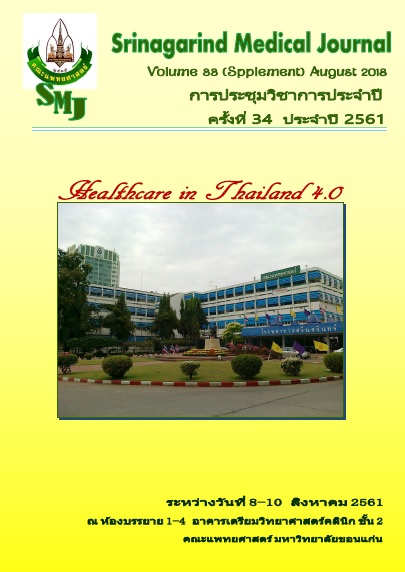Effect of Diaphragmatic Breathing Control on Heart Rate Variability in Overweight and Obese Female Adolescents
Keywords:
Adolescent; Obesity; Breathing control; Heart rate variability; วัยรุ่น; โรคอ้วน; การควบคุมการหายใจ; ค่าความแปรปรวนของการเต้นของหัวใจAbstract
Background and Objective: Obesity and overweight are associated with dysfunction of autonomic nervous system (ANS). Increased sympathetic activity is an independent risk factor for cardiovascular disease (CVD). On the contrary, enhancement of parasympathetic activity could prevent CVD. The aim of this study was to determine effect of diaphragmatic breathing control which is a physical therapy technique on changes of ANS function in overweight and obese female adolescents.
Material and Methods: In a crossover design, 12 overweight and obese female adolescents with body mass index ≥ 23 kg/m2 were recruited. They randomly performed two breathing manners consisting of a 10 minute normal breathing (spontaneous breathing) and a 10 minute diaphragmatic breathing control, with a 10 minute resting interval. Heart rate variability (HRV) which reflects ANS function, respiratory rate, heart rate, and blood pressure were measured prior and subsequent to the two breathing manners.
Results: High frequency power value of HRV following diaphragmatic breathing control was significantly higher than those following spontaneous breathing. In addition, respiratory rate, systolic blood pressure, and mean arterial blood pressure following diaphragmatic breathing control were significantly lower than that baseline and following spontaneous breathing. There was no significant difference in heart rate between breathing manners.
Conclusion: This study suggests that diaphragmatic breathing control may be a useful technique for enhancing parasympathetic nervous system activity and attenuating respiratory rate and blood pressure in overweight female adolescents.
References
2. Williams B. The changing face of hypertension treatment: treatment strategies from the 2007 ESH/ESC hypertension Guidelines. J Hypertens Suppl 2009; 27: S19-26.
3. Rerksuppaphol S and Rerksuppaphol L. Association of obesity with the prevalence of hypertension in school children from central Thailand. J Res Health Sci 2015; 15: 17-21.
4. Aekplakorn W, Hogan MC, Chongsuvivatwong V, Tatsanavivat P, Chariyalertsak S, Boonthum A, et al. Trends in obesity and associations with education and urban or rural residence in Thailand. Obesity (Silver Spring) 2007; 15: 3113-21.
5. Shi Z, Gan XB, Fan ZD, Zhang F, Zhou YB, Gao XY, et al. Inflammatory cytokines in paraventricular nucleus modulate sympathetic activity and cardiac sympathetic afferent reflex in rats. Acta Physiol (Oxf) 2011; 203: 289-97.
6. Thorp AA and Schlaich MP. Relevance of Sympathetic Nervous System Activation in Obesity and Metabolic Syndrome. J Diabetes Res 2015; 2015: 341583.
7. Khrisanapant W, Sengmeung P, Pasurivong O, and Kukongviriyapan U. Modulation of cardiac autonomic control in children and adolescents with obesity. Srinagarind Med J 2011; 26: 136-43.
8. Bernardi L, Wdowczyk-Szulc J, Valenti C, Castoldi S, Passino C, Spadacini G, et al. Effects of controlled breathing, mental activity and mental stress with or without verbalization on heart rate variability. J Am Coll Cardiol 2000; 35: 1462-9.
9. Tripathi LTK. Respiration and heart rate variability : A review with special reference to its application in aerospace medicine. Ind J Aerospace Med 2004: 64-75.
10. Vanderlei LC, Silva RA, Pastre CM, Azevedo FM, and Godoy MF. Comparison of the Polar S810i monitor and the ECG for the analysis of heart rate variability in the time and frequency domains. Braz J Med Biol Res 2008; 41: 854-9.
11. Radaelli A, Raco R, Perfetti P, Viola A, Azzellino A, Signorini MG, et al. Effects of slow, controlled breathing on baroreceptor control of heart rate and blood pressure in healthy men. J Hypertens 2004; 22: 1361-70.
12. Cooke WH, Cox JF, Diedrich AM, Taylor JA, Beightol LA, Ames JEt, et al. Controlled breathing protocols probe human autonomic cardiovascular rhythms. Am J Physiol 1998; 274: H709-18.
13. Grossman E, Grossman A, Schein MH, Zimlichman R, and Gavish B. Breathing-control lowers blood pressure. J Hum Hypertens 2001; 15: 263-9.




